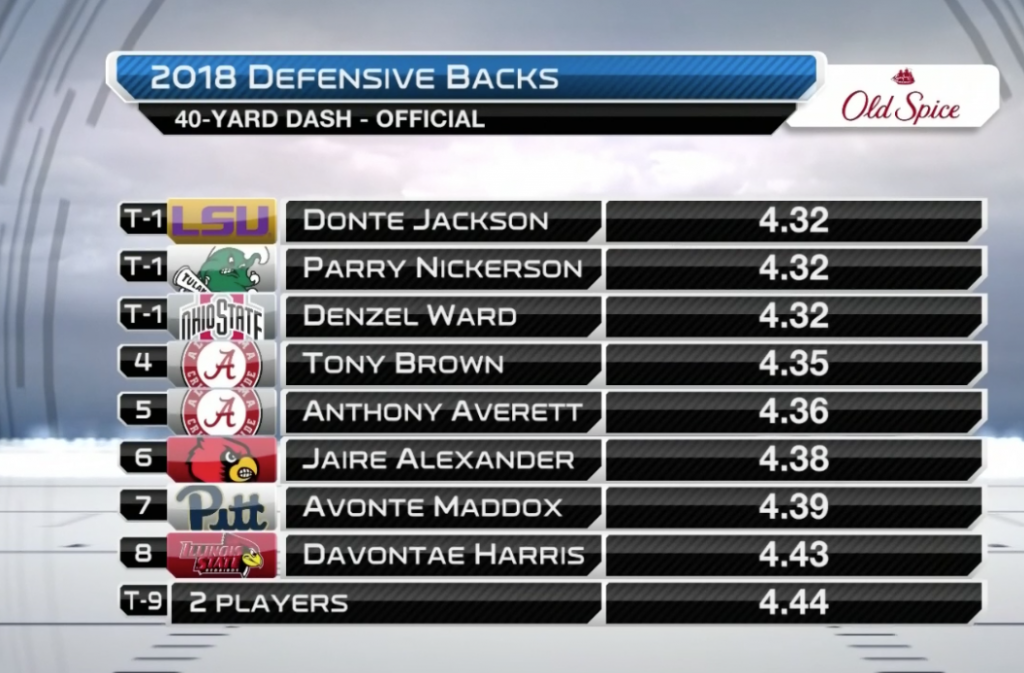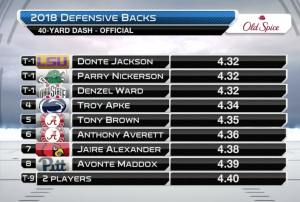Open a mock draft over the next few days and you’ll very likely see the Seahawks paired with a defensive player at #18.
Most mocks don’t include trades so it won’t really mean much. The Seahawks are as likely as any team to move down, considering they don’t own picks in rounds 2-3. Even so, the mocks are interesting to read because it’s an outsider view on where the Seahawks are at.
Unfortunately, most will overreact to the Richard Sherman departure. They’ll put a cornerback at #18 despite the fact the Seahawks have a proven record of doing the opposite. They’ve waited until day three for their corners and drafted a profile. The earliest they’ve taken a corner is round three and it’s almost certain they won’t take a corner any earlier this year.
If there’s one position Pete Carroll is comfortable coaching up, it’s corner.
The most likely early pick will be something to help the running game. Pete Carroll has identified this as a major cause for concern. Anyone following the team closely will know how desperate the situation became in 2017. One running touchdown by a back all year. That isn’t Pete Carroll football.
They’re unlikely to just blame this on the O-line too. Having invested so many early picks on the unit, it’ll likely be up to Mike Solari to get more out of the group. They might make some changes but a ‘just one more high pick‘ approach might be unlikely — even if there are some exceptional guard candidates this year (Isaiah Wynn, Will Hernandez etc).
It’s fashionable to play down the importance of the running back position but we’ll see how the Seahawks approach it in April.
If they were going to go defense early (a proposition much more likely if they acquire extra stock in rounds 2-3) it probably wouldn’t be a corner. I’m not sure it’d be a defensive lineman either. There’s isn’t any quite special enough. Nobody with Bruce Irvin’s 4.4 speed or Cliff Avril’s 1.50 split to work the edge. Marcus Davenport didn’t have a bad workout but it wasn’t particularly exciting either.
Bruce Irvin, Frank Clark, Malik McDowell — all freakishly athletic and physical in their own different way. Nobody is particularly unique among this D-line class outside of Bradley Chubb and Vita Vea.
And that’s why both Chubb and Vea will go in the top-10.
So what would the Seahawks do if they wanted to take a defensive player in round one? And what would they look for?
It’d probably have to be a player with cornerstone potential. Someone who can develop into an integral part of the next core. It’d also need to be someone with leadership qualities and eye-catching physical numbers.
Derwin James will be a name that springs to mind. It’s difficult to judge his stock at the moment. He had a terrific combine but that wasn’t unexpected. He’s considered a leader. The only thing holding him back somewhat is position (few teams take a box safety early). Are you getting a major, significant impact if you take him in round one? At Florida State his tape was, in fairness, frequently quite dull. What counters that is the ability of James to develop into a greater playmaker given his testing numbers and the impact he might provide for a young defense breaking in a new identity.
For those reasons, he could interest Seattle.
That said, there might be an even more appealing option.
I spent some time today looking closely at Leighton Vander Esch. It’s high time he earned widespread recognition as a likely top-20 pick.
His first-step quickness at 6-4 and 256lbs is legit. He explodes to the ball and has enough range to play inside or outside linebacker. So often it’s difficult for opponents to get to him — whether it’s a running back covering the blitz or even a lineman. He’s just too quick, too agile:
Leighton Vander Esch shows some good agility here as the RB tries to cut him. #BoiseState pic.twitter.com/9PJo01x8Qu
— Michael Giardi (@MikeGiardi) March 4, 2018
When he needs to power through a blocker, he can do that too:
More Leighton Vander Esch. Decent power at the point of attack. #boisestate pic.twitter.com/N4OuW6VAjL
— Michael Giardi (@MikeGiardi) March 5, 2018
We’re talking about a highly athletic, physical and at times violent player. He plays the game bigger and stronger than the opponent and has the attitude and passion on the field you want to see for the position. He loves to fill gaps vs the run, he’ll chase down the ball-carrier from behind and he has a knack for being in the right place due to an instinctive feel for the game.
Last year he had eight TFL’s, three interceptions, four sacks and four forced fumbles. At the next level he’ll be a stat machine and a playmaker.
He ran a 4.65 at the combine which is fine. Not outstanding but fine. Vander Esch more than made up for it elsewhere. He had an outstanding 4.15 short shuttle highlighting his extraordinary quickness for his size. Mike Gesicki was lauded for his short shuttle time (4.10) but Vander Esch is nine pounds heavier.
He showed off his mobility/agility during the drills:
Leighton Vander Esch moves well for a big man pic.twitter.com/JLSWK5RukV
— Cameron DaSilva (@camdasilva) March 4, 2018
He also managed a 39.5 inch vertical, a 10-4 broad and a 6.88 three-cone.
A man weighing 256lbs shouldn’t be able to move like this covering a pass to the flat (and bonus points for the hit):
Boise State has produced some impact defenders, including DeMarcus Lawrence of the Cowboys. Is Leighton Vander Esch the next? Off the ball backer. Had a very good combine. Speed and fludity on display vs Oregon. pic.twitter.com/41ca8iXxJY
— Michael Giardi (@MikeGiardi) March 4, 2018
This might be my favourite clip. Look at the way he diagnoses the play, works across the line, avoids blockers and executes the tackle. Not to mention the way he stands over the ball-carrier afterwards and gives him a little, ‘enjoy it down there’:
LB Leighton Vander Esch specializes in shutting run games down. His ability to maneuver in tight spaces, avoid trash & make tackles will be effective day 1. He also has the ability to pattern match & patrol the middle of the field. #Draft
Scouting report: https://t.co/RzaRTJL8Ta pic.twitter.com/w5flxvTM6S
— Cover 1 (@Cover_1_) February 17, 2018
Can he drop into coverage, read the play and make a pick? You bet:
INTERCEPTION!!! Who else but Leighton Vander Esch! He returns it to the Bulldog 19! Bronco ball, 1:50 to play, and the Bulldogs have no timeouts! #BleedBlue pic.twitter.com/1JH9uRBbKm
— Bill Poulson (@SmurfTurfer) December 3, 2017
Let’s look at how his testing numbers compare to some of the players already in the league:
Short shuttle
Thomas Davis — 4.01
Von Miller — 4.06
Shaq Thompson — 4.08
Luke Kuechly — 4.12
T.J. Watt — 4.13
Vic Beasley — 4.15
Leighton Vander Esch — 4.15
Sean Lee — 4.16
Khalil Mack — 4.18
Anthony Barr — 4.19
Lavonte David — 4.22
Bobby Wagner — 4.28
Jordan Willis — 4.28
Zach Cunningham — 4.29
Jamie Collins — 4.32
K.J. Wright — 4.35
Haason Reddick — 4.37
Telvin Smith — 4.57
Quicker in the short shuttle than Bobby Wagner and placed nicely between Luke Kuechly, Sean Lee, Khalil Mack and Anthony Barr. He also ran the same time as Vic Beasley.
Three cone
Von Miller — 6.70
Tyus Bowser — 6.75
T.J. Watt — 6.79
Anthony Barr — 6.82
Jordan Willis — 6.85
Leighton Vander Esch — 6.88
Sean Lee — 6.89
Vic Beasley — 6.91
Luke Kuechly — 6.92
Shaq Thompson — 6.99
Haason Reddick — 7.01
Zach Cunningham — 7.03
Telvin Smith — 7.04
Khalil Mack — 7.08
Jamie Collins — 7.10
Thomas Davis — 7.10
Bobby Wagner — 7.10
K.J. Wright — 7.21
Lavonte David — 7.28
Again, this is impressive company. This time he’s quicker than lee and Kuechly (but ran a comparable time) and was considerably quicker than Mack, Wagner and Telvin Smith.
Vertical jump
Jamie Collins — 41.5
Vic Beasley — 41
Khalil Mack — 40
Leighton Vander Esch — 39.5
Bobby Wagner — 39.5
Jordan Willis — 39
Luke Kuechly — 38
Tyus Bowser — 37.5
Sean Lee — 37.5
Von Miller — 37
T.J. Watt — 37
Lavonte David — 36.5
Thomas Davis — 36.5
Haason Reddick — 36.5
Zach Cunningham — 35
Anthony Barr — 34.5
K.J. Wright — 34
Shaq Thompson — 33.5
Telvin Smith — 31.5
It’s never a bad thing to be as explosive in the vertical jump as Bobby Wagner (despite carrying an extra 15lbs in weight). Vander Esch is again nicely placed near Mack and above Kuechly, Lee and even Von Miller.
Broad jump
Jamie Collins — 11-7
Haason Reddick — 11-1
Bobby Wagner — 11-0
Vic Beasley — 10-10
Khalil Mack — 10-8
T.J. Watt — 10-8
Tyus Bowser — 10-6
Von Miller — 10-6
Anthony Barr — 10-5
Zach Cunningham — 10-5
Jordan Willis — 10-5
Leighton Vander Esch — 10-4
Luke Kuechly — 10-3
Sean Lee — 10-0
K.J. Wright — 10-0
Lavonte David — 9-11
Telvin Smith — 9-11
Shaq Thompson — 9-9
Thomas Davis — 9-7
Vander Esch didn’t perform as well as Wagner and Mack here but he’s in the same range as Barr, Kuechly and Lee.
Forty yard dash
Bobby Wagner — 4.46
Haason Reddick — 4.52
Telvin Smith — 4.52
Vic Beasley — 4.53
Von Miller — 4.53
Jordan Willis — 4.53
Luke Kuechly — 4.58
Thomas Davis — 4.60
Sean Lee — 4.60
Jamie Collins — 4.64
Shaq Thompson — 4.64
Tyus Bowser — 4.65
Lavonte David — 4.65
Khalil Mack — 4.65
Leighton Vander Esch — 4.65
Anthony Barr — 4.66
Zach Cunningham — 4.67
T.J. Watt — 4.69
K.J. Wright — 4.71
Even in the forty yard dash — his time didn’t initially stand out but it’s as quick as Mack and and Barr and in a similar range to Kuechly and Lee.
This isn’t a draft class loaded with legit first round graded players. It’s still easy to look at certain prospects and imagine star-quality. Saquon Barkley obviously has it. I think Ronald Jones II has it too. Bradley Chubb, Vita Vea, Quenton Nelson, Tremaine Edmunds. At least a couple of the quarterbacks could become big names in the league and I wouldn’t rule out Derwin James having an excellent career too.
It’s possible a decent number from this class could become top players in the league.
Vander Esch also has that kind of feel.
He can learn to shed better but he has the arm length (34 inches) to improve there. If he plays outside it won’t be as much of an issue (he played inside for Boise State).
I think you’re talking about a player who will fly to the ball, play fast and raise the intensity level of your defense. You can trust him to play the run and pass, he’ll be instinctive and he won’t just be a tackle collector. He will make plays, force turnovers and impact games.
I’m not sure whether the Seahawks will contemplate drafting him given their needs in the running game. He could end up in Oakland, Washington or Green Bay inside the top-15. It’s not improbable.
As Seattle begins a new chapter on defense, you can’t necessarily pick and choose where your blue-chip players will come. Vander Esch would be a temporary SAM and possibly a long term WILL. If they had their full compliment of picks, Vander Esch might be able to give them the type of attitude and talent they require as they turn over a new leaf.
He might not end up in navy blue but he’s still a player worthy of a high projection this year.
You can now support Seahawks Draft Blog via Patreon by clicking the tab below.





